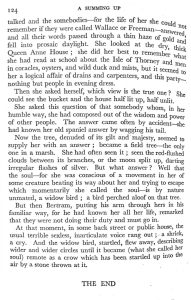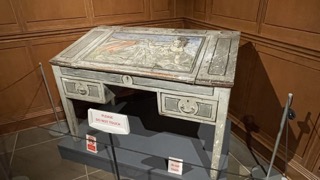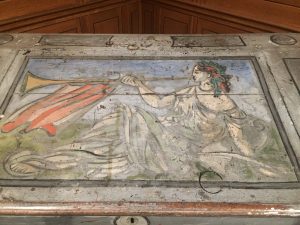A Haunted House: Virginia Woolf and the Macabre by Piper B.
I studied a 1943 Hogarth Press copy of A Haunted House and Other Stories, a short story collection by Virginia Woolf. This edition is a small hardcover book bound in red cloth with a white book jacket (Figure 1). The book jacket was designed by Woolf’s sister Vanessa Bell, and features an illustration of a vase of roses centered in front of a lattice window. The black and white illustration, accompanied by the eerie title in a large, wobbly font, primes readers for an experience with the macabre. The arranged roses are somehow simultaneously wild and wilting. The space behind the window is dark, while the window paneling is white, giving viewers an impression of external darkness but internal light– a theme echoed by Woolf’s focus on the life of the internal mind throughout the collection.
As explained in the foreword, this collection was pieced together by Woolf’s husband Leonard after her death in an attempt to honor her wishes to expand her initial published collection, Monday or Tuesday (Figure 2). He expressed that he included six unpublished stories that she had not fully revised, for a total of eighteen stories comprising the 123-page volume. One immediately notable aspect of the interior formatting and layout is that the individual stories are not physically separated by a page break– e.g., see Figure 3 with the end of “The Mark on the Wall” transitioning to the beginning of “The New Dress” on the same page. This lack of physical dissociation contributes to the reader’s sense that the stories will also be thematically interconnected. I also noted that Hogarth Press is a publishing company originally founded by Leonard and Virginia, which lends an intimate feeling to the collection and suggests that Leonard had a large modicum of control over the process of its publication (https://hogarthbooks.com/).
“A Haunted House” being both the first and titular story determines the atmosphere for the remainder of the collection, providing a lens through which to read the other stories. This is one of the most surrealist stories in the collection, a modernist ghost story featuring death and life meeting on parallel planes. I also saw the decision to highlight this particular story as a reflection on love and death in the context of Leonard’s arrangement of this collection for Woolf posthumously– noting the “ghostly couple” searching for the “light in the heart.” This story and the ones going forward also establish a pattern of strong impressionism, deconstructing events and the flow of time into a stream-of-consciousness flow of sensual, emotional experiences. Often these take the structure of “The Mark on the Wall,” in which something tangible inspires an intangible train of thought. While some of the other stories, like “The New Dress,” do stay more firmly grounded in reality, others utilize language and imagery that continue to blur the line between the imagination and the physical world, with “Lappin and Lapinova” featuring an odd dissociation and shifting of reality in which a marriage evolves into a fantasy pairing of Queen Lapinova (a hare) and King Lappin (a rabbit). “The Shooting Party” is a ghostly, darker counterpart to “A Haunted House,” with a steady flow of imagery such as “rotten” and “gray mist” to describe the downfall and decomposition of an aristocratic family.
I saw “The Lady in the Looking Glass” as the height of the gothic and surrealist fantasy in the collection, in which Woolf fully embraces the chilling atmosphere and even ventures into what I would call psychological horror.
Appropriately, the collection ends with a story titled “A Summing Up,” with the final page concluding with “The End” in larger, all caps letters (Figure 4). This feels reminiscent of a fairy tale ending— a final leaning into the surreal— and again contributes to the reading of the stories as a cohesive unit with a beginning and end.
Figure 1: Book jacket cover

Figure 2: Inside book flap of cover introducing the contents of the collection, summarizing the main contents of the foreword

Figure 3: Example of the interconnected appearance of the story, with the end of “The Mark on the Wall” transitioning to the beginning of “The New Dress”

Figure 4: The final page of the collection, the end of “A Summing Up” with “The End” at the bottom











Recent Comments